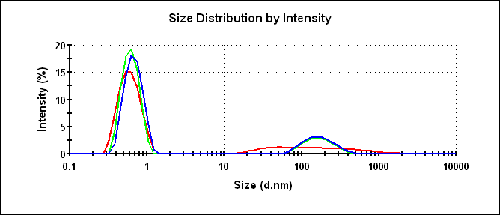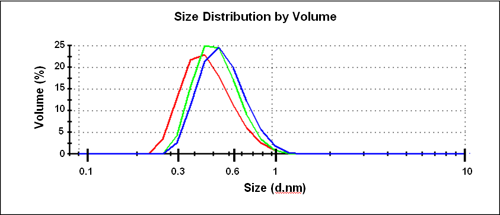For the Zetasizer Nano S90 or ZS90 instrument, the minimum size specification (diameter) is a peak mode of 0.6nm with a minimum size of 0.3nm. This technical note contains details of the experimental procedures and results obtained from measurements of sucrose solutions as demonstration of these minimum size specifications.
A 20% w/v solution of sucrose was prepared (20g of sucrose made up to 100g with deionized water) and the sample filtered through the 20nm pore-size filter into a suitable cuvette.
The measurements were taken at 25°C using a viscosity of 1.74mPa.s.
The intensity size distributions obtained from 3 repeat measurements of a 20% w/v sucrose solution are shown in figure 1 with the corresponding volume size distributions shown in figure 2. As described in the application note MRK1120, and the published paper MRK1034, the second peak in the intensity plot, and also seen as the 'bump' in the right of the correlation function (figure 3), is ascribed to collective diffusion of the sucrose molecules.

|

|
In terms of a volume distribution, there is only one peak with a mode of 0.6nm diameter as the larger peak is insignificant when the Mie transformation to volume is applied. This 0.6nm peak has a width with a distribution extending down to 0.3nm diameter (figure 4).

|

|
The overplot of the three correlation functions (figure 3) shows the repeatability of the data, which translates into the repeatability of the result.
The repeatability is not as good as observed with the data produced by the Zetasizer Nano S or ZS. This is because of the lower level of scattering intensity. The measurement times are longer, each of these measurements was 20 minutes duration, but even so the points in the correlation function do not form such a smooth curve as would be required for the more repeatable result of the Zetasizer Nano S and ZS. To improve the data quality by a factor of 2, the measurement time must be four times greater. With the difference in sensitivity between the 90 degree scattering systems compared with the backscatter systems, the time taken to get equivalent data would be impractical.
The results reported in this technical note confirm that the minimum size capability (diameter) of the Zetasizer Nano S90 or ZS90 is a peak mode of 0.6nm with a minimum size of 0.3nm.